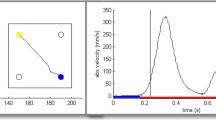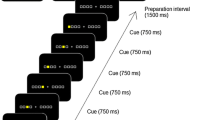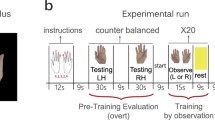Abstract
Previous research on motor sequence learning (MSL) in the elderly has focused mainly on unilateral tasks, even though bilateral coordination might be impaired in this age group. In this fMRI study, 28 right-handed elderly subjects were recruited. The paradigm consisted of a Novel and a simple Control sequence executed with the right (R), left (L) and both hands (B). Behavioral performance (Accuracy[AC], Inter-tap Interval[ITI]) and associated brain activity were assessed during early learning. Behavioral performance in the Novel task was similar between unilateral conditions whereas in the bimanual condition more errors and slower motor execution were observed. Brain activity increases during learning showed differences between Conditions: R showed increased activity in pre-SMA, basal ganglia and left hippocampus while B showed activity increments mainly in posterior parietal cortex and cerebellum. L did not show any activity modulation during learning. Performance correlates for AC (related to spatial success) and ITI (related to accurate timing) shared a cortico-basal-cerebellar network. However, it was found that the ITI regressor presented additional significant correlations with activity in SMA and basal ganglia in R. The AC regressor showed additional significant correlations with activity in more extended thalamic and cerebellar areas in B. The present findings suggest that, behaviorally, the spatial and temporal components of MSL are impaired in elderly subjects when using both hands. Additionally, differential brain activity patterns were found across hand modalities. The results obtained reveal the existence of a highly specialized network in the dominant hand and identify areas specifically involved in bimanual coordination.










Similar content being viewed by others
References
Albouy, G., Sterpenich, V., Balteau, E., Vandewalle, G., Desseilles, M., Dang-Vu, T., Darsaud, A., Ruby, P., Luppi, P., Degueldre, C., Peigneux, P., Luxen, A., Maquet, P., 2008. Both the hippocampus and striatum are involved in consolidation of motor sequence memory. 58(2):261-72
Albouy, G., Fogel, S., King, B. R., Laventure, S., Carrier, J., Doyon, J., Benali, H., Karni, A., & Robertson, E. M. (2015). Maintaining vs. enhancing motor sequence memories: respective roles of striatal and hippocampal systems. NeuroImage, 108, 423–434.
Aznarez-Sanado, M., Fernandez-Seara, M., Loayza, F., & Pastor, M. (2013). Functional asymmetries in early learning during right, left, and bimanual performance in right-handed subjects. Journal of Magnetic Resonance Imaging, 37, 619.
Bangert, A. S., Reuter-Lorenz, P., Walsh, C. M., Schachter, A. B., & Seidler, R. D. (2010). Bimanual coordination and aging: neurobehavioral implications. Neuropsychologia, 48, 1165–1170.
Bhakuni, R., & Mutha, P. K. (2015a). Learning of bimanual motor sequences in normal aging. Frontiers in Aging Neuroscience, 7, 76–76.
Bhakuni, R., & Mutha, P. K. (2015b). Learning of bimanual motor sequences in normal aging. Frontiers in Aging Neuroscience, 7, 76.
Chen, S. H. A., & Desmond, J. E. (2005). Temporal dynamics of cerebro-cerebellar network recruitment during a cognitive task. Neuropsychologia, 43, 1227–1237.
Daselaar, S. M., Rombouts, S. A. R. B., Veltman, D. J., Raaijmakers, J. G. W., & Jonker, C. (2003). Similar network activated by young and old adults during the acquisition of a motor sequence. Neurobiology of Aging, 24, 1013–1019.
Debaere, F., Wenderoth, N., Sunaert, S., Van Hecke, P., & Swinnen, S. P. (2004a). Changes in brain activation during the acquisition of a new bimanual coodination task. Neuropsychologia, 42, 855–867.
Debaere, F., Wenderoth, N., Sunaert, S., Van Hecke, P., & Swinnen, S. P. (2004b). Cerebellar and premotor function in bimanual coordination: parametric neural responses to spatiotemporal complexity and cycling frequency. NeuroImage, 21, 1416–1427.
Diedrichsen, J. (2006). A spatially unbiased atlas template of the human cerebellum. NeuroImage, 33, 127–138.
Doyon, J., Laforce, R. J., Bouchard, G., Gaudreau, D., Roy, J., Poirier, M., Bédard, P. J., Bédard, F., & Bouchard, J. (1998). Role of the striatum, cerebellum and frontal lobes in the automatization of a repeated visuomotor sequence of movements. Neuropsychologia, 36, 625–641.
Doyon, J., Song, A. W., Karni, A., Lalonde, F., Adams, M. M., & Ungerleider, L. G. (2002). Experience-dependent changes in cerebellar contributions to motor sequence learning. Proceedings of the National Academy of Sciences of the United States of America, 99, 1017.
Doyon, J., Penhune, V., & Ungerleider, L. G. (2003). Distinct contribution of the cortico-striatal and cortico-cerebellar systems to motor skill learning. Neuropsychologia, 41, 252–262.
Doyon, J., Bellec, P., Amsel, R., Penhune, V., Monchi, O., Carrier, J., Lehericy, S., & Benali, H. (2009). Contributions of the basal ganglia and functionally related brain structures to motor learning. Behavioural Brain Research, 199, 61.
Fernández-Seara, M. A., Aznárez-Sanado, M., Mengual, E., Loayza, F. R., & Pastor, M. A. (2009). Continuous performance of a novel motor sequence leads to highly correlated striatal and hippocampal perfusion increases. NeuroImage, 47, 1797–1808.
Gheysen, F., Van Opstal, F., Roggeman, C., Van Waelvelde, H., & Fias, W. (2010). Hippocampal contribution to early and later stages of implicit motor sequence learning. Experimental Brain Research, 202(4), 795–807.
Ghilardi, M. F., Moisello, C., Silvestri, G., Ghez, C., & Krakauer, J. W. (2009). Learning of a sequential motor skill comprises explicit and implicit components that consolidate differently. Journal of Neurophysiology, 101, 2218–2229.
Graziadio, S., Nazarpour, K., Gretenkord, S., Jackson, A., & Eyre, J. A. (2015). Greater intermanual transfer in the elderly suggests age-related bilateral motor cortex activation is compensatory. Journal of Motor Behavior, 47, 47–55.
Hoff, M., Ragert, P., 2015. Switching between hands in a serial reaction time task: A comparison between young and old adults. 7, 176
Hoff, M., Trapp, S., Kaminski, E., Sehm, B., Steele, C. J., Villringer, A., & Ragert, P. (2015). Switching between hands in a serial reaction time task: a comparison between young and old adults. Frontiers in Aging Neuroscience, 7, 176–176.
Howard, D. V., Howard, J. H. J., Japikse, K., DiYanni, C., Thompson, A., & Somberg, R. (2004). Implicit sequence learning: effects of level of structure, adult age, and extended practice. Psychology and Aging, 19, 79–92.
Jäncke, J. H. R., Specht, K., Mirzazade, S., & Peters, M. (1999). The effect of finger-movement speed of the dominant and the subdominant hand on cerebellar activation. A functional magnetic resonance imaging study., 9(5), 497–507.
King, B. R., Fogel, S. M., Albouy, G., & Doyon, J. (2013). Neural correlates of the age-related changes in motor sequence learning and motor adaptation in older adults. Frontiers in Human Neuroscience, 7, 142.
Klein, A., Andersson, J., Ardekani, B. A., Ashburner, J., Avants, B., Chiang, M., Christensen, G. E., Collins, D. L., Gee, J., Hellier, P., Song, J. H., Jenkinson, M., Lepage, C., Rueckert, D., Thompson, P., Vercauteren, T., Woods, R. P., Mann, J. J., & Parsey, R. V. (2009). Evaluation of 14 nonlinear deformation algorithms applied to human brain MRI registration. NeuroImage, 46, 786–802.
Lehéricy, S., Benali, H., Van, D. M., Pélégrini-Issac, M., Waechter, T., Ugurbil, K., Doyon, J., & Ungerleider, L. G. (2005). Distinct basal ganglia territories are engaged in early and advanced motor sequence learning. Proceedings of the National Academy of Sciences of the United States of America, 102, 12566.
Luis, E. O., Arrondo, G., Vidorreta, M., Martínez, M., Loayza, F., Fernández-Seara, M. A., & Pastor, M. A. (2015). Successful working memory processes and cerebellum in an elderly sample: a neuropsychological and fMRI study. PloS One, 10, e0131536.
Müller, R., Kleinhaus, N., Pierce, K., Kemmotsu, N., & Courchesne, E. (2002). Functional MRI of motor sequence acquisition: effects of learning stage and performance. Cognitive Brain Research, 14, 277–293.
Muller, R. A., Kleinhans, N., Pierce, K., Kemmotsu, N., & Courchesne, E. (2002). Functional MRI of motor sequence acquisition: effects of learning stage and performance. Cognitive Brain Research, 14, 277–293.
Nair, D. G., Purcott, K. L., Fuchs, A., Steinberg, F., & Kelso, J. A. S. (2003). Cortical and cerebellar activity of the human brain during imagined and executed unimanual and bimanual action sequences: a functional MRI study. Cognitive Brain Research, 15, 250–260.
O’Reilly, J. X., Beckmann, C. F., Tomassini, V., Johansen-Berg, H., & Ramnani, N. (2010). Distinct and overlapping functional zones in the cerebellum defined by resting state functional connectivity. Cerebral Cortex, 20, 953–965.
Oldfield, R. C. (1971). The assessment and analysis of handedness: the Edinburgh inventory. Neuropsychologia, 9, 97–113.
Penhune, V. B., & Steele, C. J. (2012). Parallel contributions of cerebellar, striatal and M1 mechanisms to motor sequence learning. Behavioural Brain Research, 226, 579–591.
Reuter-Lorenz, P., & Cappell, K. A. (2008). Neurocognitive aging and the compensation hypothesis. Current Directions in Psychological Science, 17, 177.
Rieckmann, A., Fischer, H., & Backman, L. (2010). Activation in striatum and medial temporal lobe during sequence learning in younger and older adults: relations to performance. NeuroImage, 50, 1303.
Sadato, N., Yonekura, Y., Waki, A., Yamada, H., & Ishii, Y. (1997). Role of the supplementary motor area and the right premotor cortex in the coordination of bimanual finger movements. The Journal of Neuroscience., 17, 9667–9674.
Schendan, H. E., Searl, M. M., Melrose, R. J., & Stern, C. E. (2003). An fMRI study of the role of the medial temporal lobe in implicit and explicit sequence learning. Neuron, 37, 1013–1025.
Schendan, H. E., Tinaz, S., Maher, S. M., & Stern, C. E. (2013). Frontostriatal and mediotemporal lobe contributions to implicit higher-order spatial sequence learning declines in aging and parkinson’s disease. Behavioral Neuroscience, 127, 204–221.
Schulz, R., Wessel, M. J., Zimerman, M., Timmermann, J. E., Gerloff, C., & Hummel, F. C. (2015). White matter integrity of specific dentato-thalamo-cortical pathways is associated with learning gains in precise movement timing. Cerebral Cortex, 25, 1707–1714.
Seidler, R. D., Bernard, J. A., Burutolu, T. B., Fling, B. W., Gordon, M. T., Gwin, J. T., Kwak, Y., & Lipps, D. B. (2010). Motor control and aging: links to age-related brain structural, functional, and biochemical effects. Neuroscience and Biobehavioral Reviews, 34, 721–733.
Serrien, D. J. (2008). Coordination constraints during bimanual versus unimanual performance conditions. Neuropsychologia, 46, 419–425.
Serrien, D. J. (2009). Functional connectivity patterns during motor behaviour: the impact of past on present activity. Human Brain Mapping, 30, 523–531.
Serrien, D. J., Swinnen, S. P., & Stelmach, G. E. (2000). Age-related deterioration of coordinated interlimb behavior. Journals of Gerontology: Series B., 55(5), P295–P303.
Steele, C. J., & Penhune, V. B. (2010). Specific increases within global decreases: a functional magnetic resonance imaging investigation of five days of motor sequence learning. The Journal of Neuroscience., 30, 8332–8341.
Stoodley, C. J., & Schmahmann, J. D. (2009). Functional topography in the human cerebellum: a meta-analysis of neuroimaging studies. NeuroImage, 44, 489–501.
Swinnen, S.P., Wenderoth, N., 2004. Two hands, one brain: Cognitive neuroscience of bimanual skill. Trends Cogn. Sci. (Regul. Ed. ). 8, 18–25.
Verneau, M., van, D. K., Savelsbergh, G. J. P., & de Looze, M. P. (2014). Age and time effects on implicit and explicit learning. Experimental Aging Research, 40, 477–511.
Wadden, K., Brown, K., Maletsky, R., & Boyd, L. A. (2013). Correlations between brain activity and components of motor learning in middle- aged adults: an fMRI study. Frontiers in Human Neuroscience, 7, 16.
Walsh, R. R., Small, S. L., Chen, E. E., & Solodkin, A. (2008). Network activation during bimanual movements in humans. NeuroImage, 43, 540–553.
Wang, J., & Sainburg, R. L. (2009). Generalization of visuomotor learning between bilateral and unilateral conditions. Journal of Neurophysiology, 102, 2790–2799.
Author information
Authors and Affiliations
Corresponding author
Ethics declarations
Funding
This project has been supported by grants from Fundación para la Investigación Médica Aplicada (FIMA), Universidad de Navarra and Centro de Investigación Biomédica de Red de Enfermedades Neurodegenerativas (CIBERNED). Luis Eudave is supported by a grant from the Friends of the University of Navarra Association.
Conflict of interest
The authors declared that they have no conflict of interest.
Ethical approval
All procedures followed were in accordance with the ethical standards of the responsible committee on human experimentation (institutional and national) and with the Helsinki Declaration of 1975, and the applicable revisions at the time of the investigation. Informed consent was obtained from all patients for being included in the study.
Additional information
Luis Eudave and Maite Aznárez-Sanado contributed equally to this article.
Electronic supplementary material
Supplementary Figure 1
(DOCX 91 kb)
Supplementary Figure 2
(DOCX 34 kb)
Supplementary Table 1
(DOCX 16 kb)
Supplementary Table 2
(DOCX 20 kb)
Supplementary Table 3
(DOCX 18 kb)
Supplementary Table 4
(DOCX 20 kb)
Supplementary Table 5
(DOCX 12 kb)
Rights and permissions
About this article
Cite this article
Eudave, L., Aznárez-Sanado, M., Luis, E.O. et al. Motor sequence learning in the elderly: differential activity patterns as a function of hand modality. Brain Imaging and Behavior 11, 986–997 (2017). https://doi.org/10.1007/s11682-016-9569-7
Published:
Issue Date:
DOI: https://doi.org/10.1007/s11682-016-9569-7




